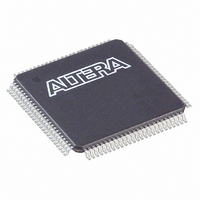EPM7064AETC100-10N Altera, EPM7064AETC100-10N Datasheet - Page 16

EPM7064AETC100-10N
Manufacturer Part Number
EPM7064AETC100-10N
Description
IC MAX 7000 CPLD 64 100-TQFP
Manufacturer
Altera
Series
MAX® 7000Ar
Datasheet
1.EPM7032AELC44-10N.pdf
(64 pages)
Specifications of EPM7064AETC100-10N
Programmable Type
In System Programmable
Delay Time Tpd(1) Max
10.0ns
Voltage Supply - Internal
3 V ~ 3.6 V
Number Of Logic Elements/blocks
4
Number Of Macrocells
64
Number Of Gates
1250
Number Of I /o
68
Operating Temperature
0°C ~ 70°C
Mounting Type
Surface Mount
Package / Case
100-TQFP, 100-VQFP
Voltage
3.3V
Memory Type
EEPROM
Number Of Logic Elements/cells
4
Family Name
MAX 7000A
# Macrocells
64
Number Of Usable Gates
1250
Frequency (max)
125MHz
Propagation Delay Time
10ns
Number Of Logic Blocks/elements
4
# I/os (max)
68
Operating Supply Voltage (typ)
3.3V
In System Programmable
Yes
Operating Supply Voltage (min)
3V
Operating Supply Voltage (max)
3.6V
Operating Temp Range
0C to 70C
Operating Temperature Classification
Commercial
Mounting
Surface Mount
Pin Count
100
Package Type
TQFP
Cpld Type
EEPROM
No. Of Macrocells
64
No. Of I/o's
84
Propagation Delay
10ns
Global Clock Setup Time
6.2ns
Frequency
100MHz
Supply Voltage Range
3V To 3.6V
Rohs Compliant
Yes
Lead Free Status / RoHS Status
Lead free / RoHS Compliant
Features
-
Lead Free Status / Rohs Status
Compliant
Other names
544-2007
EPM7064AETC100-10N
EPM7064AETC100-10N
Available stocks
Company
Part Number
Manufacturer
Quantity
Price
Company:
Part Number:
EPM7064AETC100-10N
Manufacturer:
ALTERA30
Quantity:
82
Part Number:
EPM7064AETC100-10N
Manufacturer:
ALTERA/阿尔特拉
Quantity:
20 000
MAX 7000A Programmable Logic Device Data Sheet
In-System
Programma-
bility
16
MAX 7000A devices can be programmed in-system via an industry-
standard 4-pin IEEE Std. 1149.1 (JTAG) interface. ISP offers quick, efficient
iterations during design development and debugging cycles. The
MAX 7000A architecture internally generates the high programming
voltages required to program EEPROM cells, allowing in-system
programming with only a single 3.3-V power supply. During in-system
programming, the I/O pins are tri-stated and weakly pulled-up to
eliminate board conflicts. The pull-up value is nominally 50 kΩ.
MAX 7000AE devices have an enhanced ISP algorithm for faster
programming. These devices also offer an ISP_Done bit that provides safe
operation when in-system programming is interrupted. This ISP_Done
bit, which is the last bit programmed, prevents all I/O pins from driving
until the bit is programmed. This feature is only available in EPM7032AE,
EPM7064AE, EPM7128AE, EPM7256AE, and EPM7512AE devices.
ISP simplifies the manufacturing flow by allowing devices to be mounted
on a PCB with standard pick-and-place equipment before they are
programmed. MAX 7000A devices can be programmed by downloading
the information via in-circuit testers, embedded processors, the Altera
MasterBlaster serial/USB communications cable, ByteBlasterMV parallel
port download cable, and BitBlaster serial download cable. Programming
the devices after they are placed on the board eliminates lead damage on
high-pin-count packages (e.g., QFP packages) due to device handling.
MAX 7000A devices can be reprogrammed after a system has already
shipped to the field. For example, product upgrades can be performed in
the field via software or modem.
In-system programming can be accomplished with either an adaptive or
constant algorithm. An adaptive algorithm reads information from the
unit and adapts subsequent programming steps to achieve the fastest
possible programming time for that unit. A constant algorithm uses a pre-
defined (non-adaptive) programming sequence that does not take
advantage of adaptive algorithm programming time improvements.
Some in-circuit testers cannot program using an adaptive algorithm.
Therefore, a constant algorithm must be used. MAX 7000AE devices can
be programmed with either an adaptive or constant (non-adaptive)
algorithm. EPM7128A and EPM7256A device can only be programmed
with an adaptive algorithm; users programming these two devices on
platforms that cannot use an adaptive algorithm should use EPM7128AE
and EPM7256AE devices.
The Jam Standard Test and Programming Language (STAPL), JEDEC
standard JESD 71, can be used to program MAX 7000A devices with in-
circuit testers, PCs, or embedded processors.
Altera Corporation














